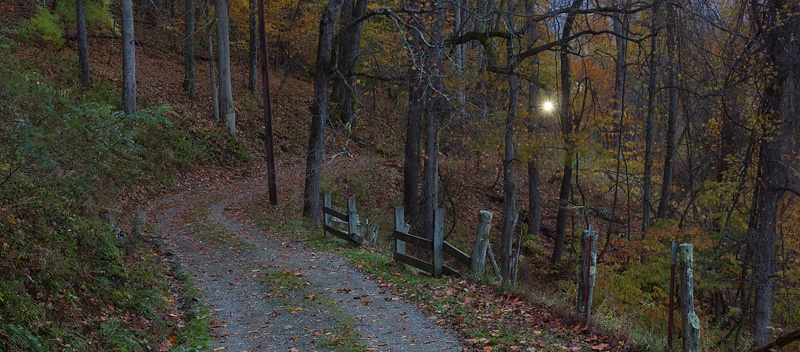
The Spooklight Phenomenon and related Folklore

You're probably wondering, "What's a Spooklight?"
Spooklights are an unexplained phenomenon. They are lights of unknown origin, generally described as spheres of light that appear with some regularity in specific locations, usually along old roadways or abandoned railroad tracks. In contemporary folklore, these mysterious lights are commonly attributed to supernatural mischief of some sort, most often involving the restless wanderings of the ghosts of men killed in local train accidents.
Numerous other theories of a less fantastical nature have been proposed, of course. These include the rare occurrence of ball lightning, or the more common phenomenon of swamp gas, also known as the "Will 'o the Wisp" - burning methane gas emitted by bogs, taking the form of glowing spheres that can travel when blown by the wind (for a detailed discussion of the Will 'o the Wisp, see this wikipedia article). At present, it seems that science has yet to establish a clear understanding of the physics behind the origin and behavior of either ball lightning or swamp lights, despite the fact that both of these are universally acknowledged to be genuine phenomena of the natural world.
Some of the more recent "scientific" spooklight explanations, which purport to be more technologically advanced and sophisticated, often seem nearly as preposterous as the ghost stories that they are meant to replace - such newfangled ideas include the theory of "earth lights" caused by tectonic strain along natural fault lines in the earth, where massive friction against certain types of rock is said to produce an electric charge which somehow manifests as a light above the surface of the ground. Perhaps - but, as of yet, this hypothesis remains just as bereft of tangible evidence as the more popular theory that blames the wandering dead.
My personal opinion is that most of these lights probably have a far less exotic origin, in the form of car headlights and other artificial light sources that simply happen to be viewed from a distance along very unexpected lines of sight. The Paulding Light in northern Michigan is an excellent example of such a circumstance of coincidental topography; for a discussion of my own detailed examination of the locale of this spooklight, please follow the link to my Paulding Light page.
Headlights can be seen from many miles away, and may be further enhanced or distorted in strange ways by the common effect of the mirage, which can cause a distant light to appear closer and brighter than it really is. Amazingly, one variety of this illusion, called a "superior mirage," can even reveal a light which would otherwise be hidden beyond the viewer's horizon line. All that's required for such a mirage is the occurrence of an inversion layer, a vertical change of air temperature (colder below, warmer above). An informative website about mirages offers this quotation:
"We tend to observe mirages most often during the daylight, but superior mirage conditions commonly occur during the night. Indeed, inversion formation is much more frequent during the night hours, at times occurring nightly for long stretches. The advent and spread of artificial light sources during the twentieth century, particularly moving light sources such as the headlights of cars and trucks, can produce some interesting visions. For example, the superior mirage could be the source for many nighttime UFO sightings. Here's why. The light from headlights on automobiles moving along the highway can be refracted under inversion conditions so that they appear to come from the heavens rather than from the surface where they originated. These images can appear to move quickly across the sky, or they can disappear suddenly as the angle or position of the light beam from the moving vehicle changes."
http://www.islandnet.com/~see/weather/elements/supmrge.htm
But don't let all of this sober rationality get you down. There are many spooklights in America, and there's still a chance that at least one of them is of truly mysterious origin. Regardless of their exact nature, I've found spooklights to be a fascinating topic of study for a couple of reasons.
For one, I take an interest in all manner of luminous phenomena - natural or supernatural origin notwithstanding. This is directly related to my artistic pursuits, since all representational painting involves the observation of effects of light. Light is beautiful and intriguing stuff, especially considering the innumerable ways in which light can be reflected, refracted, diffused, bent and warped by the interference of atmosphere, water, and other influences.
But spooklights are most appealing simply for the folklore that has surrounded them for more than a hundred years. If you've already visited other pages in the Sleepy Hollow wing of my website, you've probably deduced that ghost stories involving headless beings are popular here at kitgentry.com. American spooklight lore abounds with headless ghosts, who are most often said to have met their fates through gruesome collisions with oncoming trains. The train-accident theme is so common that it can be found attached to spooklights even in areas where no train tracks ever existed anywhere near the light.
The repetitive train theme is clearly derived from the story behind America's oldest and best-known spooklight, the Maco Light in North Carolina. For your convenience and entertainment, I've compiled a wide variety of accounts of this famous light - you can find them at the following link: The Maco Light.
The Moonville Tunnel in Ohio is another site associated with a spooklight legend; I visited this location in November of 2017, and have compiled a detailed account of its history, illustrated with my own photographs of the site: The Moonville Tunnel.